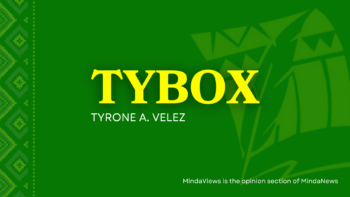DAVAO CITY (MindaNews/04 May) — Besides entertainment, the purpose that dance has long served included conveying ideas, emotions, and messages that no other medium can communicate dramatically, if not clearly.
But the theatrical complexities that comprise dance often make it seem distant to the people detached from all things art. The myriad forms of performances sometimes make it difficult for the audience to take in the specific messages that dance wants to convey.
In today’s tech-driven world, it appears that taking in dance as a medium is a complicated process. It also doesn’t help that many of us are growing to become people with short attention span who don’t have the luxury of time to see through one long dance performance just to have that “ahh, I get it” moment.
Is dance still a relevant medium?
Folks from the University of the Philippines Mindanao Dance Ensemble, who recently just staged their annual dance concert, share their answer and show their best form.
 “Dance is the only agent that can easily articulate the politics and psychology of spaces,” said Gloryrose Dy, UP Mindanao Dance Ensemble alumna. “And this can be translated to the psychology of man–emotions, ideas, etc. It is also a kind of medium that is extremely subtle in telling the truth but extremely powerful in making people see the truth.”
“Dance is the only agent that can easily articulate the politics and psychology of spaces,” said Gloryrose Dy, UP Mindanao Dance Ensemble alumna. “And this can be translated to the psychology of man–emotions, ideas, etc. It is also a kind of medium that is extremely subtle in telling the truth but extremely powerful in making people see the truth.”
Dy, who was this year’s coach and creative director of the dance group for the concert, had this to say when asked about the importance of dance in our time: “Dance in our time is not about performing for the sake of the audience. We are done with that during the renaissance times. Dance today is beyond that—it is beyond expression and beyond performance. It is already an agent–or something greater–that we can’t even decipher.”
This year, the UP Mindanao Dance Ensemble’s dance concert explored the art form’s history of movements. These included looking into the “biomimicry of movements,” as Dy described, to show dance as an agent for social change and an agent to emphasize certain stories of society.
Describing this year’s dances, Jealmer Phoenix Delgado, the dance group’s leader and lead choreographer, said, “We have decided to adapt the concept of ‘change’ for this year’s production. Change brings development in all aspects of life; this is the same with dance. The changes in dance that we have highlighted included how it flourished from simple basic body movements during the old times, to contemporary dance moves in the present. That is also why we called the concert ‘Galaw, Indak, Sayaw.’”
“Galaw is the simple movement of the body–a motion or a dance that does not require any instruction or technique in order for a person to interpret. It is as simple as hand-raise and/or basic footwork,” Delgado said. “Indak speaks of how, as time goes by, people have learned and incorporated expression to their day-to-day living. And with all the changes and improvements happened over time, people gained knowledge on the concept and spirit of dance—hence, Sayaw. Dance has transpired various classifications, genres and interpretations practiced by people. But more than that, the repertoire showcases the interrelatedness of those simple movements and expressions in the modern body kinesics and pool of emotions that we now have in dance.”
To Delgado, dance remains relevant in the community today because “it serves as an avenue for voicing out feelings that are difficult to articulate using words.” With dance, he said, they are able to “communicate and convey messages that can be understood and interpreted by people coming from different walks of life.”
“As a dancer, dance gives me an opportunity to show my thoughts and emotions that are left unspoken,” he said. (Jesse Pizarro Boga/MindaNews)
